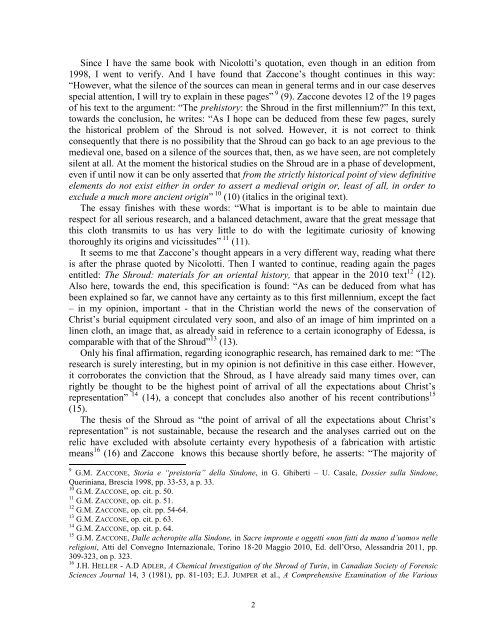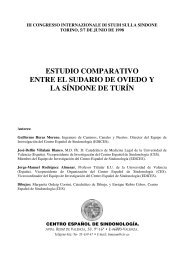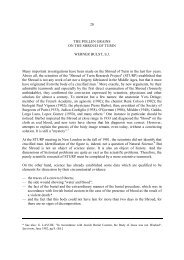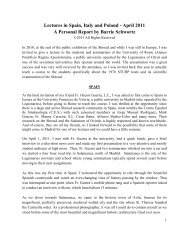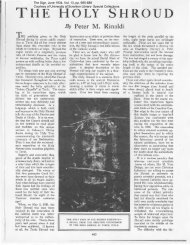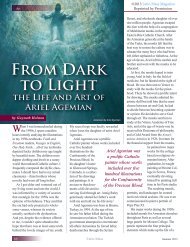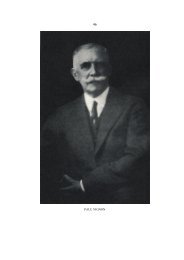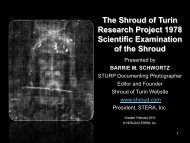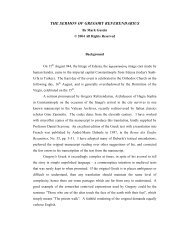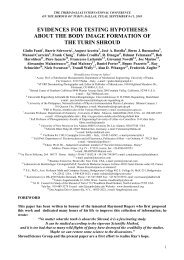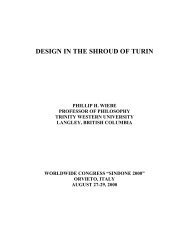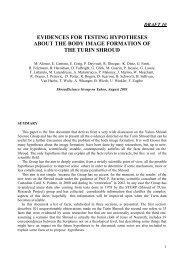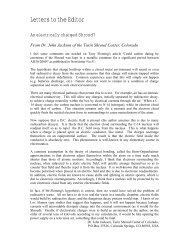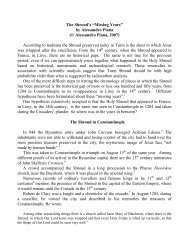BSTS Newsletter No. 74 - Part 8 - The Shroud of Turin Website
BSTS Newsletter No. 74 - Part 8 - The Shroud of Turin Website
BSTS Newsletter No. 74 - Part 8 - The Shroud of Turin Website
You also want an ePaper? Increase the reach of your titles
YUMPU automatically turns print PDFs into web optimized ePapers that Google loves.
Since I have the same book with Nicolotti’s quotation, even though in an edition from1998, I went to verify. And I have found that Zaccone’s thought continues in this way:“However, what the silence <strong>of</strong> the sources can mean in general terms and in our case deservesspecial attention, I will try to explain in these pages” 9 (9). Zaccone devotes 12 <strong>of</strong> the 19 pages<strong>of</strong> his text to the argument: “<strong>The</strong> prehistory: the <strong>Shroud</strong> in the first millennium?” In this text,towards the conclusion, he writes: “As I hope can be deduced from these few pages, surelythe historical problem <strong>of</strong> the <strong>Shroud</strong> is not solved. However, it is not correct to thinkconsequently that there is no possibility that the <strong>Shroud</strong> can go back to an age previous to themedieval one, based on a silence <strong>of</strong> the sources that, then, as we have seen, are not completelysilent at all. At the moment the historical studies on the <strong>Shroud</strong> are in a phase <strong>of</strong> development,even if until now it can be only asserted that from the strictly historical point <strong>of</strong> view definitiveelements do not exist either in order to assert a medieval origin or, least <strong>of</strong> all, in order toexclude a much more ancient origin” 10 (10) (italics in the original text).<strong>The</strong> essay finishes with these words: “What is important is to be able to maintain duerespect for all serious research, and a balanced detachment, aware that the great message thatthis cloth transmits to us has very little to do with the legitimate curiosity <strong>of</strong> knowingthoroughly its origins and vicissitudes” 11 (11).It seems to me that Zaccone’s thought appears in a very different way, reading what thereis after the phrase quoted by Nicolotti. <strong>The</strong>n I wanted to continue, reading again the pagesentitled: <strong>The</strong> <strong>Shroud</strong>: materials for an oriental history, that appear in the 2010 text 12 (12).Also here, towards the end, this specification is found: “As can be deduced from what hasbeen explained so far, we cannot have any certainty as to this first millennium, except the fact– in my opinion, important - that in the Christian world the news <strong>of</strong> the conservation <strong>of</strong>Christ’s burial equipment circulated very soon, and also <strong>of</strong> an image <strong>of</strong> him imprinted on alinen cloth, an image that, as already said in reference to a certain iconography <strong>of</strong> Edessa, iscomparable with that <strong>of</strong> the <strong>Shroud</strong>” 13 (13).Only his final affirmation, regarding iconographic research, has remained dark to me: “<strong>The</strong>research is surely interesting, but in my opinion is not definitive in this case either. However,it corroborates the conviction that the <strong>Shroud</strong>, as I have already said many times over, canrightly be thought to be the highest point <strong>of</strong> arrival <strong>of</strong> all the expectations about Christ’srepresentation” 14 (14), a concept that concludes also another <strong>of</strong> his recent contributions 15(15).<strong>The</strong> thesis <strong>of</strong> the <strong>Shroud</strong> as “the point <strong>of</strong> arrival <strong>of</strong> all the expectations about Christ’srepresentation” is not sustainable, because the research and the analyses carried out on therelic have excluded with absolute certainty every hypothesis <strong>of</strong> a fabrication with artisticmeans 16 (16) and Zaccone knows this because shortly before, he asserts: “<strong>The</strong> majority <strong>of</strong>9 G.M. ZACCONE, Storia e “preistoria” della Sindone, in G. Ghiberti – U. Casale, Dossier sulla Sindone,Queriniana, Brescia 1998, pp. 33-53, a p. 33.10 G.M. ZACCONE, op. cit. p. 50.11 G.M. ZACCONE, op. cit. p. 51.12 G.M. ZACCONE, op. cit. pp. 54-64.13 G.M. ZACCONE, op. cit. p. 63.14 G.M. ZACCONE, op. cit. p. 64.15 G.M. ZACCONE, Dalle acheropite alla Sindone, in Sacre impronte e oggetti «non fatti da mano d’uomo» nellereligioni, Atti del Convegno Internazionale, Torino 18-20 Maggio 2010, Ed. dell’Orso, Alessandria 2011, pp.309-323, on p. 323.16 J.H. HELLER - A.D ADLER, A Chemical Investigation <strong>of</strong> the <strong>Shroud</strong> <strong>of</strong> <strong>Turin</strong>, in Canadian Society <strong>of</strong> ForensicSciences Journal 14, 3 (1981), pp. 81-103; E.J. JUMPER et al., A Comprehensive Examination <strong>of</strong> the Various2


